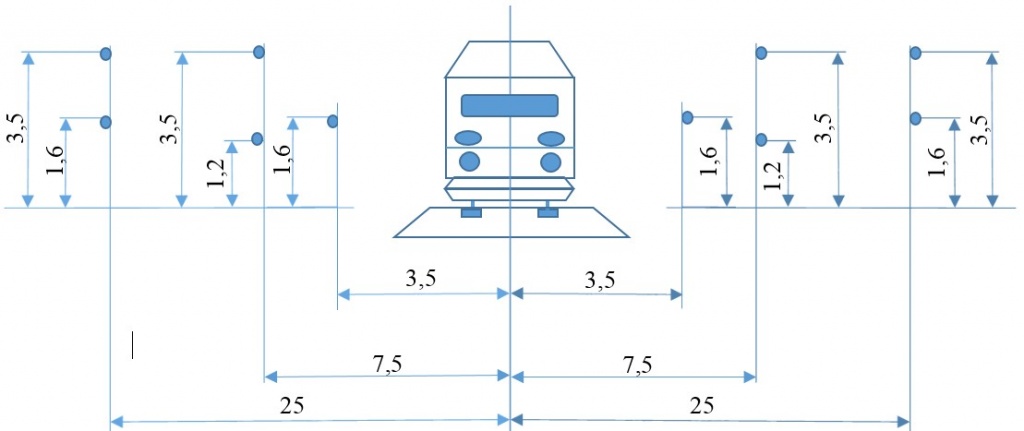Railroad train acoustic noise measuring system
Railroad trains are among the most eco-friendly types of transport:
- they practically do not pollute environment because discharge of harmful substances is minimal
- efficient use of energy resources
- a small area of seats held
However, along with advantages there are also disadvantages. The hugest problem of trains is the increased noise, which bothers residents of houses, situated close to the rails. According to sanitary standards the maximum admissible sound pressure level in territories adjacent to houses should not exceed 70 dBA (from 7 h to 23 h) and 60 dBA (from 23 h to 7 h). But in fact, the passing train provides noise increase as much as 80-90 dB. Russian trains are noisier than the European railroad transport models, 7-10 dBA more. Noise characteristics of rail transport with traffic intensity of 3-4 pairs/hour at a distance of 25 m is 71-82 dBA, depending on the type of traffic (passenger or freight trains).
That is why the high acoustic impact caused by movement of the rail transport is an urgent problem for all towns and villages, especially for big cities.
Continuous monitoring of noise, constant monitoring of excess levels compared with the set limits allows preventing the occurrence of the problems described above.
Automated system for measuring acoustic noise ensures continuous monitoring and identification of noise and registration of noise levels. The system allows detecting the excess of the permissible noise and sending the information to the operator. This system also performs all day sounds registering, performs data collection and processing of the noise parameters. This way of an assessment of noise level is the most economically efficient when it is necessary to carry out long-term or simultaneous measurements.
Control of noise level increase can be useful not only for the main railway tracks, but also for highways, industrial zones, concert halls and construction territories. Most often monitoring has to be applied in case of imposing by a city administration of restriction for noise in the city, for protection against complaints from the population and conscientious owners of the companies who cause a significant acoustic influence.
Measuring instruments used in the system are the following: microphones, cables, recording device, ZET 110 sound level meter. All sound meters must be Class 1 sound level meters according to IEC 61672-1:2002 and IEC 61260. ZETLab software consisting of ZET 110 can store data and process it later using PC. The software also allows you to connect a microphone directly to a sound level meter.
Measurements are made in accordance with IEC 61672-1:2002. Place for measuring of acoustical impact of the railway equipment should provide conditions of free acoustic sound field and smooth surface within one meter relative to the rails. There shouldn’t be any reflecting surfaces around the microphone. Wind speed can also affect the measurement, which must not exceed 5 m/s. The background noise level should not exceed 10 dBA.
The standard position of the microphones (in meters):

To measure the external noise of the railway equipment in the lay-over the microphone shall be located at a distance of 7.5 meters from the longitudinal axis at a height of 1.6 ± 0.2 m from the level. In order to ensure audibility of spoken language when measuring in the lay-over, microphones should be located at a distance of 3.5 m and 1.6 m.
To measure the external noise of the railway equipment during its movement with constant velocity, microphones must be arranged on both sides at a distance of 7.5 m from the axis, and at a height of 1.2 from the rail level and two other microphone must be placed at a distance of 25 m from the axis and at a height of 1.6 m. If the upper part of the railway equipment has sources of intense noise, additional microphones should be placed on both sides at a distance of 7.5 m and 25 m, at a height of 3.5 m.
Time of train passing is measured by an optical sensor. The measurements are usually conducted at uniform train speeds such as 20, 40, 60, 80, 100, 120, 140, 160, 200, 250, 300, 320, 350 km/h. During tests, three measurements at each point of the microphone are taken, then the average mean of the measured values is calculated. One measurement at each microphone is carried out for control measurements. If data differs by more than 3 dB then new measurements are taken. If the measurements differ on both sides, the highest values are considered as being valid.
The measurement results conducted in accordance with IEC 61672-1:2002 necessarily contain information about type of test, date and venue, a list of equipment involved in the measurements, the background noise levels, modes of operation during measurements, the type designation of the railway equipment, the layout of the microphones, the presence of pulse and tone noise, any other information on request.
The measurement results can be used:
- to monitor the performance of the railway equipment noise;
- to determine the difference between the noise of different types of rail transport;
- for building a database of trains external noise.
